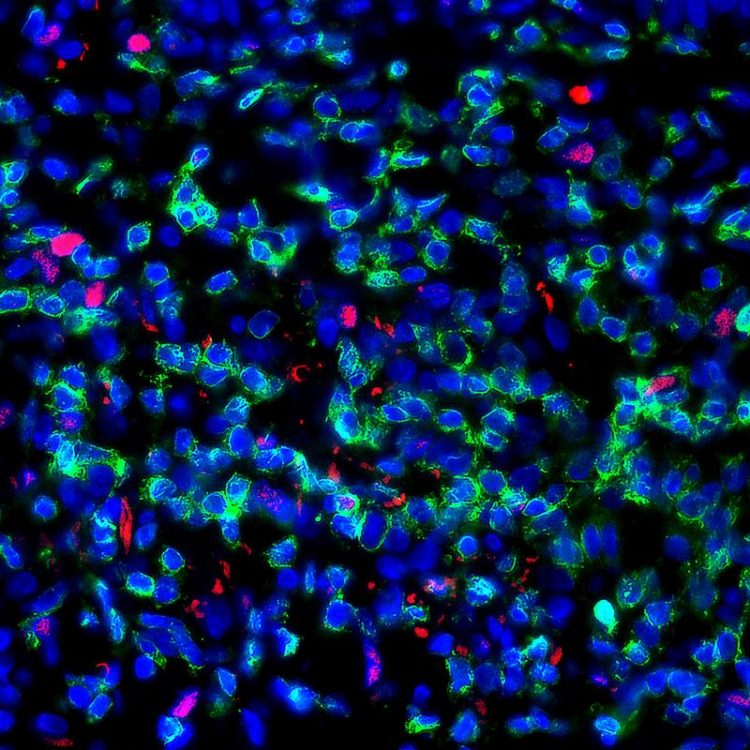Cellular metabolism as the key to treating allergic dermatitis?

The immunfluorescence shows TH cells (in green, CD4+) in the skin of a patient with acute allergic contact dermatitis. Several of these cells express the transcription factor PPAR-γ (in red). Department of Dermatology, Inselspital, Bern University Hospital
The function of so-called “TH9” cells in humans remains elusive. These interleukin-9 (IL-9)-producing T helper (TH) cells play an important role in inflammatory reactions and tumor immunity in animal models.
In order to better understand the role of TH9 cells in humans, Prof. Dr. Christoph Schlapbach and his research team at the Department of Dermatology at Inselspital and the Department for Biomedical Research at the University of Bern have examined these cells in greater depth.
Closely related allergy-inducing T cells
Most notably, the team discovered that TH9 cells are not a separate population, but rather a distinct subpopulation of the already known TH2 cells which contribute decisively to the induction of allergies. As a result, they were characterised as “IL-9+ TH2 cells”.
Consistent with this interrelation, the researchers have found that this cell type is involved in such allergic skin diseases as atopic dermatitis (atopic eczema, neurodermatitis) or allergic contact eczema.
In order to understand how the new cells can be distinguished from conventional TH2 cells, the team carried out modern transcriptomic analyses. In the course of this, the transcription factor PPAR-γ was identified as an important regulator of IL-9+ TH2 cells.
PPAR-γ is a well-known regulator of cellular metabolism, i.e. the processes occurring in cells to produce energy and biologic building blocks. Until now, the function of PPAR-γ in fat and muscle cells was known, but its function in TH cells has only recently been examined.
An old acquaintance and new therapeutic approaches
PPAR-γ has already been used as a therapeutic target for treating type 2 diabetes. The fact that it also plays a key role in IL-9+ TH2 cells therefore opens up new ways for treating such allergic skin diseases as neurodermatitis.
“Because PPAR-y regulates the cells that have now been characterised, we might be able to manipulate this cell population with it,” explains Christoph Schlapbach.
“It is therefore conceivable that already existing medications can be used to treat diseases in which IL-9+ TH cells are involved, a process called “drug repositioning”.”
Before this hypothesis can be tested in initial clinical trials, the researchers now want to examine more closely how IL-9 and PPAR-y interact in allergic skin conditions. For this purpose, continuation studies are currently being carried out at the Department of Dermatology at Inselspital.
Prof. Dr. med. Christoph Schlapbach, Senior Physician, Prof. Dr. med. Christoph Schlapbach, Senior Physician, Department of Dermatology, Inselspital, Bern University Hospital, and Department of BioMedical Research, University of Bern, Christoph.Schlapbach@insel.ch.
DOI: 10.1126/sciimmunol.aat5943
Media Contact
More Information:
http://www.insel.chAll latest news from the category: Life Sciences and Chemistry
Articles and reports from the Life Sciences and chemistry area deal with applied and basic research into modern biology, chemistry and human medicine.
Valuable information can be found on a range of life sciences fields including bacteriology, biochemistry, bionics, bioinformatics, biophysics, biotechnology, genetics, geobotany, human biology, marine biology, microbiology, molecular biology, cellular biology, zoology, bioinorganic chemistry, microchemistry and environmental chemistry.
Newest articles

NASA: Mystery of life’s handedness deepens
The mystery of why life uses molecules with specific orientations has deepened with a NASA-funded discovery that RNA — a key molecule thought to have potentially held the instructions for…

What are the effects of historic lithium mining on water quality?
Study reveals low levels of common contaminants but high levels of other elements in waters associated with an abandoned lithium mine. Lithium ore and mining waste from a historic lithium…

Quantum-inspired design boosts efficiency of heat-to-electricity conversion
Rice engineers take unconventional route to improving thermophotovoltaic systems. Researchers at Rice University have found a new way to improve a key element of thermophotovoltaic (TPV) systems, which convert heat…



